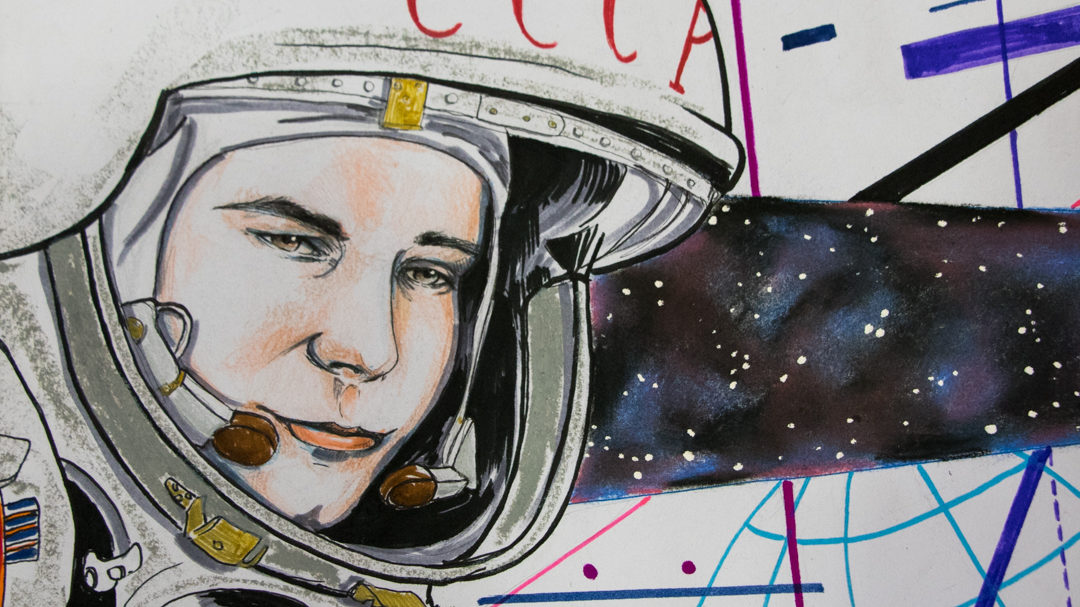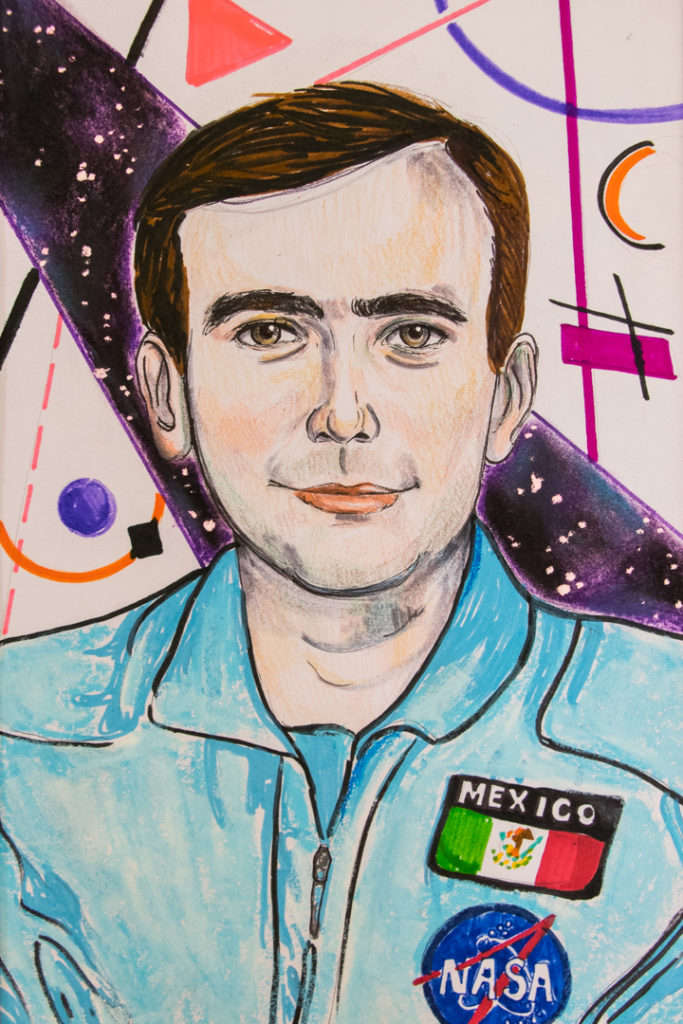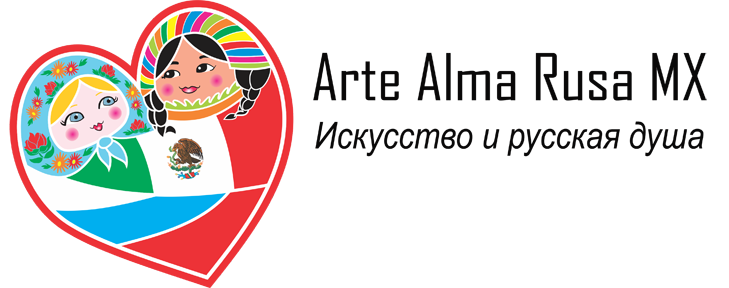
Mexico and Russia united by the Cosmos: Icons of Cosmonautics
Illustrations: Daniela Oliveros (@darbol_o)
Under the 58 anniversary of the arrival of the first cosmonaut into space, Soviet pilot Yuri Gagarin, Russian art Alma MX launched the project “Mexico and Russia united by the Cosmos”, formed by exposure of illustrations by the visual artist Daniela Oliveros, paintings by the visual artist Francisco Marquez and photographs of the author of this website, Gabriela Oliveros.
Our purpose is to present the protagonists of the Russian aircraft through history, who have become icons of history through the work of scientists and professionals from various fields for generations, and turn, we recognize the Mexicans who have entered the space race outstandingly in various programs.
konstantin Tsiolkovski
"The Earth is the cradle of humanity, but you can not live in a cradle forever "
He born in Izhévskoye, in the province of Ryazan, south of Moscow. Tsiolkovski educated self-employed in libraries in Moscow and in the books of his father, because he could not attend school. At ten, a fever resulted in a hearing loss. The problem motivated him to excel and prove that it could be as good as people without disabilities.
He published more than 500 work on space travel and related topics, including the first known project of a space elevator.
His notebooks are filled with sketches of liquid propulsion rocket, Detailed with paddles on the steering exhaust plume for directional control designs, pressurized cabins double to protect against meteorites, detailed design of combustion chambers, gyroscopes for the altitude control, reclining seats to protect against high acceleration during takeoff and air bags G to exit the spacecraft in the vacuum of space.
In the Kaluga region, where he lived for a long period, wrote cosmic philosophy, dreaming about the distant future of mankind, including the eventual conquest of space and our solar system:
https://es.wikipedia.org/wiki/Konstant%C3%ADn_Tsiolkovski
At a time

The dog Laika was the first living being to travel into space. The 3 November 1957 It was placed in the Sputnik 2, Soviet ship whose mission was to orbit Earth.
Laika was in a capsule the size of a washer, with a device for chemical regeneration air and an automatic feeder which opened, twice daily, the lid of a container with a mixture of gelatinous nutrient.
The dog will implanted sensor ribs to measure his breathing and another sensor for measuring pulse at the carotid artery. Also activated devices for measuring temperature, pressure and make cardiograms. In the last days, before launch, Laika was placed in a capsule every day, for several hours, to be used to the situation.
During the launch, the rhythm of the pulsations of the dog rose much. Temperature sensors showed that the humidity and temperature of the capsule where the dog was increased shortly after the start of the mission. Six hours after takeoff, sensors registered a cardiac arrest.
Laika's story is perhaps best known because it became one of the great Soviet victories in the space race.
https://www.bbc.com/mundo/noticias-41861654
Belka y Strelka

Strelka ("Flechita") and Belka ("Squirrel" or "whitey"), like other canine cosmonauts Soviet under the direction of Vladimir Yazdovski, small animals were just six kilos with an endearing aspect. Despite its delicate appearance, His mission was paramount: check that the Vostok ship was suitable for the first manned flight history. Although they were the protagonists of the mission, not travel alone.
The 19 August 1960, Belka and Strelka were one day in space aboard Sputnik 5 and they returned healthy. With them were several animals (rabbit, 42 mice, two rats), plants and fungi. This was the first trip in which all survived into orbit.
Strelka had six puppies with a male dog named pushok, which he participated in various spatial tests but never went into space. In 1961, Nikita Khrushchev President gave to Caroline Kennedy, daughter of President John F. Kennedy, one of the puppies named Pushinka.
Possibly, Pushinka and dog President, Charlie, They had four puppies, what came to be classified as a romance during the Cold War, while Kennedy called pupniks comically. Today, Belka and Strelka desiccated can be seen at the Museum of Cosmonautics in Moscow.
https://danielmarin.naukas.com/2010/08/19/50-anos-de-strelka-y-belka/
Yuri Gagarin
"I looked prays to heaven, prays to Earth. Large lakes and mountains clearly discerned. Even looked fields. The most beautiful view was the horizon: a painted by all colors of the rainbow that separated the black sky Earth in the light of the sun's rays band. bunching looked, the roundness of the Earth. It seemed that all she was encircled by a halo light blue, that through turquoise, blue and purple pass the black " (Y. Gagarin. Way to the cosmos). So Earth saw the first human being in space, Yuri Gagarin.
Born in 1934 in a small village near the town of Gzhatsk (Currently Gagarin), Smolensk province (Central Russia). It was steelworker up 1954, when he pointed at the flying club of the city of Saratov. That was when he began his racing career.
Late 1959 fighter pilot Yuri Gagarin applied for membership in the group of candidates for cosmonaut, successfully passed all tests and in early March 1960 entered in the group and began training.
The election of the first cosmonaut was due to several factors, and not only the perfect physiological indices and expert knowledge of equipment. A face reflected kindness and open soul of Yuri Gagarin beat everyone he worked with the young driver and, according to one of the many legends surrounding his figure after his space flight, was the head of the Soviet state then, Nikita Jruschov, who at the photographs of the candidates elected the first cosmonaut.
But before the historic date of the first flight of a human into space, all these candidates had to go a long way in one year, full training in sensory deprivation chambers and barometric chambers, in centrifuges and other simulators, experiment after experiment, parachute jumps after flight on a Tu-104 converted into a flying laboratory (on this plane the simulated weightlessness).
For his feat Gagarin was named Hero of the Soviet Union, and several awards being awarded the highest Order of Lenin. Soon he enjoyed great fame, not only in Russia, but around the world. "The mission of peace", as they called in the press the first cosmonaut tour across continents, It lasted two years. Gagarin made numerous visits to other countries, visiting 30 States in total; He met with thousands of people; kings and presidents, politicians and scientists, artists and musicians had for honor shake hands. He received a very warm welcome in Cuba (Gagarin later became president of the Society of Soviet-Cuban Friendship).
In 1963 Gagarin was appointed deputy head of the Cosmonaut Preparation Center.
Yuri Gagarin died tragically 27 March 1968 while conducting training exercises on the aircraft MiG-15 along with aviator instructor Vladimir Serioguin. During flight, the pilots did not report any malfunction, but suddenly he stopped communicating with them and the plane crashed.
Gagarin's name leads the city near which was born the first cosmonaut, a crater on the dark side of the moon and an asteroid, as well as a research vessel, the cosmonaut training center in Star City and countless streets, squares and schools across Russia. By decision of the International Aeronautical Federation, the 12 April is World Day of Aviation and Astronautics.
valentina Tereshkova
On earth, men and women run the same risks. Why should not we do the same in space?
Soviet cosmonaut Valentina Tereshkova's born in the Yaroslavl region of Russia. Valentina began to be interested in parachute jumps at an early age. It was his skydiving experience which allowed him to be selected as a cosmonaut. Tereshkova was a worker in a textile factory and an amateur parachutist when she was selected to be part of the program cosmonauts. Under the direction of Soviet premier Nikita Khrushchev, four women were selected to be trained in a special program for women in space. Of the four selected, only Valentina Tereshkova completed a space mission.
Tereshkova was launched aboard Vostok 6 the 16 June 1963 and she became the first woman to fly in space. During 70,8 flight hours, la Vostok 6 orbited Earth 48 times. After completing its mission, Tereshkova was honorificada with the title of Hero of the Soviet Union. He never again flies, but she became a spokeswoman for the Soviet Union. While serving his role as spokesman for the Soviet Union he was awarded the Peace Medal awarded by the United Nations.
Tereshkova is now the last living person who has manned Vostok spacecraft, the first generation of space manned space flight.
Valery Bykovsky

The cosmonaut was the 11th person to reach space, but his record for the duration of his solo space travel has not been exceeded.
Valery Fyodorovich Bykovsky was born 2 August 1934 in the town of Pavlovsky Posad, near Moscow. In November 1955, the young man graduated with honors from the Military Aviation Academy Kachinsk, and the following year began pilot work.
After being selected as a cosmonaut, Bykovsky made the historic trip. The mission lasted from 14 al 19 June 1963. Cosmonaut set his record by staying 5 days in the Vostok 5, in a historic flight that orbited the Earth 82 times.
During this mission, Bykovsky came close to making a rendezvous to orbit a few kilometers of the first woman cosmonaut, Valentina Vladímirovna Tereshkova, aboard Vostok 6.
In September 1976, his second space flight cosmonaut performed on the Soyuz mission 22. Bykovsky and Vladimir Aksyonov colleague spent a week in orbit photographing the surface of the Earth with a camera built specially.
The last flight of cosmonaut took place in the Soyuz spacecraft 31, which it was coupled orbiting space station Salyut 6 the 28 August 1978.
Bykovsky y Sigmund Jähn, the first German in space, they passed 6 days in the space station, with cosmonauts Vladimir Kovalyonok residents and Aleksandr Ivanchenkov.
The mission was Bykovsky and Jähn carry supplies to the crew of the station and conduct scientific experiments there.
Total, Bykovsky spent in space almost 21 days, or more accurately 20 days, 17 hours and 47 minutes, a significant milestone in its time.
Bykovsky retired from the cosmonaut corps in 1982 and then he worked in various roles at the Yuri Gagarin Cosmonaut Training Center, and Star City, near Moscow. He died last 27 of March
https://www.bbc.com/mundo/noticias-47749399
svetlana Savítskaya
After that flight, and no one had questions. Nobody said cosmonautics was exclusively for boys. no longer they dare to say, but not all, Of course, they liked.
It is a Soviet pilot and cosmonaut. He became the second woman to go into space to man the Soyuz T-7 1982, 19 years after the flight of Valentina Tereshkova.
During his work as a test pilot learned to master over 20 types of aircraft. Savitskaya also practiced skydiving, where he established 3 world records in the group jumps with a parachute from the stratosphere and 15 world records reagents aircraft. He was also world champion in aerobatics on piston aircraft 1970. For its sporting achievements, in 1970 He received the title of Merited Master of Sports of the USSR. In 1980 He entered the group of cosmonauts (Women's Group Cosmonaut No. 2 1980), where he made a full preparation for space flight on the Soyuz craft type T. It was between the 19 and the 27 August 1981 when Savitskaya made his first space flight as a scout cosmonaut Soyuz T. The flight lasted 7 days, 21 hours, 52 minutes 24 seconds.
After the flight, engineer Valentin Glushko, one of the three main leaders designers (along with Vladimir Chelomey and Sergei Korolyov) spacecraft and Soviet missiles, He sentenced with conviction: "Now the way is open space for women!”
Of the 17 al 25 July 1984 Savístskaya made his second flight into space as engineer aboard the Soyuz T-12 and during their stay at the space station Salyut-7 25 July 1984, the cosmonaut Savitskaya became the first woman to spacewalk. He stood outside the station 3 hours and 35 minutes.
From the years 70 Savítsakaya last century began to devote himself to social work. He served as vice president of the Peace Foundation of the USSR (organization that funded different political projects of the USSR).
http://rusopedia.rt.com/ciencia_y_tecnica/espacio/issue_233.html#Svetlana%20Sav%C3%ADtskaya
Sergei Volkov and anton Shkaplerov

Volkov is the first cosmonaut “second generation”, son of the cosmonaut Aleksandr Volkov. He born in Chuguyev, Currently in Ukraine. He trained as a pilot and engineer 1995.
He has the medal Hero of the Russian Federation and several decorations of the Russian Armed Forces.
After graduating from the military academy, He has flown with aircraft L-29, L-39, el Ilyushin Il-22, and Tupolev Tu-134, reaching accumulate 450 flight hours.
In June 2006 It is part of the Expedition 17, besides Commander of the Soyuz TMA-12. He was the youngest Commander of the ISS station. His last mission was from April to October 2008.
———————————–
In May 2003 Shkaplerov was selected as a candidate for the test of the Office of Yuri Gagarin Cosmonaut Training Center. Of June 2003 June 2005 he attended basic space training and was qualified as a test cosmonaut 2005.
From April to October 2007, Shkaplerov served as COO of the Russian Space Agency, based at the Johnson Space Center in Houston, Texas.
The commander of the expedition 54, Alexander Misurkin, and flight engineer Anton Shkaplerov of the Russian space agency Roscosmos spent outside the orbital complex 8 hours and 13 minutes. It is the longest Russian spacewalk, surpassing the previous record of 8 hours and 7 minutes Oleg Kotov and Sergei Ryazanskiy established the 27 from December to 2013, in a space walk during expedition 38.
Rodolfo Vela Blacks

Originating in Chilpancingo, Guerrero, he graduated in Communications and Electronics Engineer at the Faculty of Engineering of the UNAM. He made his Masters in Telecommunications Systems at the University of Essex, England, and subsequently he received his doctorate from the University of Birmingham, Also in England, in the area of Applied Electromagnetism.
In 1985 He was selected to become Mexico's first astronaut and the first representative of a Latin American country on a mission of NASA. Orbited Earth 109 times on the space shuttle Atlantis and during the mission three communications satellites were placed in orbit. He made various experiments and an extensive photographic work of the Earth's surface. In addition to his experience with NASA, The doctor. Neri Vela collaborated later, in 1989 and 1990, with the European Space Agency, in Holland, in the project of the International Space Station, it is currently in orbit around Earth.
He has written about 15 books on science, in the fields of astronautics and astronomy: Mexico in Space (The Blue Planet), Build and install your own satellite dish, Inhabited Space Stations, Sun and Eclipses, Around the World in Ninety Minutes, Exploration of the Universe and Little Astronaut and the Red Planet, among others. For several years, until recently, He had a science column in national newspaper The universal.
His experiences as an astronaut, Writer, speaker, professor and engineer it one of the best science writers in the country and inspiration and motivation for generations.
He is a member of the Academy of Engineering, College of Mechanical and Electrical Engineers, and the Mexican Society of Geography and Statistics. For years he was one of the main promoters for the creation of the Mexican Space Agency, which eventually it became law in July 2010.
http://rodolfonerivela.com/trayectoria/
José Hernández Moreno

Jose Hernandez is one of the most internationally renowned Mexican astronauts. Electronics engineer, expert on space missions, It is a celebrity in Mexico, where his relatives still live and where their parents left in 1957 to United States.
This Mexican astronaut took part in 2009 in the mission number 128 NASA, traveling on the Discovery to provide supplies and equipment to the Leonardo Station, a mission that was completed in 332 hours.
Before getting to be an astronaut, Joseph's life was not easy because of their family situation. During his childhood, he worked in the agricultural fields of California, with his parents Mexican migrant workers, and she did not learn English, until he was 12 years. But nevertheless, despite this, Hernandez got his degree and get the master's degree in electrical engineering and, in 1987, he went to work at the Lawrence Livermore National Laboratory in California, becoming an expert in X-ray physics and helping to develop the full field of the first digital mammography system. Likewise, during a season in the Department of Energy, He assisted in the disposal of nuclear materials in Russia and 2001 he moved to Houston to work at the Johnson Space Center as an engineer.
Finally, after twelve years of intense work, in 2004, He was selected as an astronaut. Doctor Honoris Causa by the University of the Pacific, Jose Hernandez gives motivational speeches, He is explaining their life experience.
http://grupobcc.com/mx/speakers/jose-hernandez/




